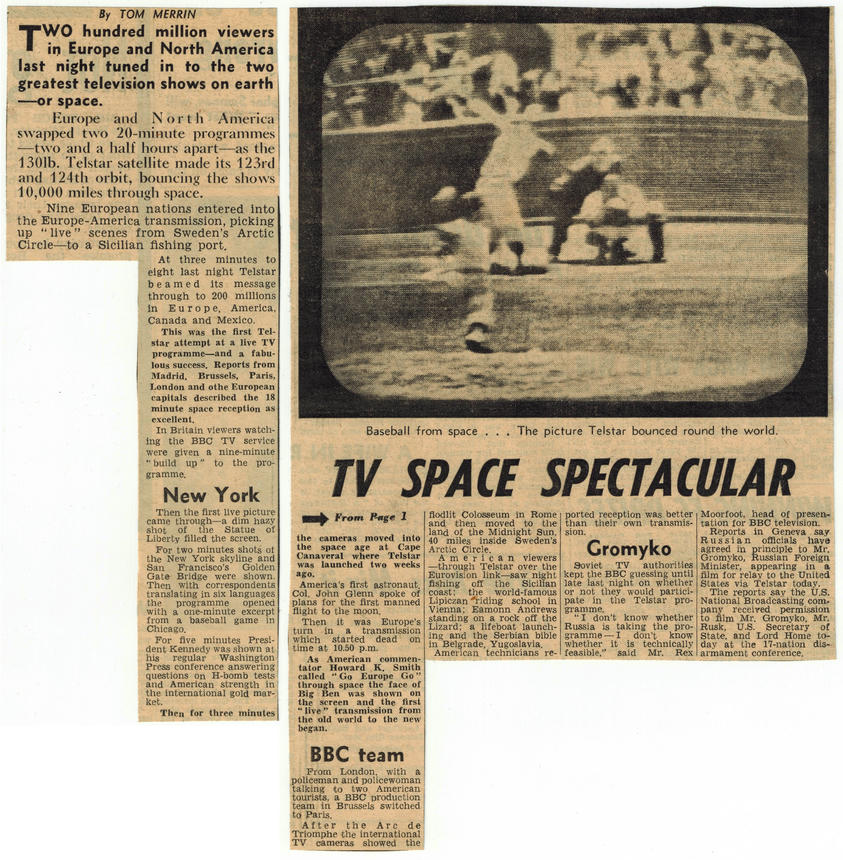Scrapbook 3: Two hundred million viewers tuned in, TV Space Spectacular

By TOM MERRIN
TWO hundred million viewers in Europe and North America last night tuned in to the two greatest television shows on earth—or space.
Europe and North America swapped two 20-minute programmes—two and a half hours apart—as the 130lb. Telstar satellite made its 123rd and 124th orbit, bouncing the shows 10,000 miles through space.
Nine European nations entered into the Europe-America transmission, picking up “live” scenes from Sweden’s Arctic Circle—to a Sicilian fishing port.
At three minutes to eight last night Telstar beamed its message through to 200 millions in Europe, America, Canada and Mexico.
This was the first Telstar attempt at a live TV programme—and a fabulous success. Reports from Madrid, Brussels, Paris, London and othe European capitals described the 18 minute space reception as excellent.
In Britain viewers watching the BBC TV service were given a nine-minute “build up” to the programme.
New York
Then the first live picture came through—a dim hazy shot of the Statue of Liberty filled the screen.
For two minutes shots of the New York skyline and San Francisco’s Golden Gate Bridge were shown. Then with correspondents translating in six languages the programme opened with a one-minute excerpt from a baseball game in Chicago.
For five minutes President Kennedy was shown at his regular Washington Press conference answering questions on H-bomb tests and American strength in the international gold market.
Then for three minutes
Baseball from space . . . The picture Telstar bounced round the world.
TV SPACE SPECTACULAR
From Page 1
the cameras moved into the space age at Cape Canaveral where Telstar was launched two weeks ago.
America’s first astronaut, Col. John Glenn spoke of plans for the first manned flight to the moon.
Then it was Europe’s turn in a transmission which started dead on time at 10.50 p.m.
As American commentator Howard K. Smith called “Go Europe Go” through space the face of Big Ben was shown on the screen and the first “live” transmission from the old world to the new began.
BBC team
From London, with a policeman and policewoman talking to two American tourists, a BBC production team in Brussels switched to Paris.
After the Arc de Triomphe the international TV cameras showed the flodlit Colosseum in Rome and then moved to the land of the Midnight Sun, 40 miles inside Sweden’s Arctic Circle.
American viewers—through Telstar over the Eurovision link—saw night fishing off the Sicilian coast; the world-famous Lipiczan riding school in Vienna; Eamonn Andrews standing on a rock off the Lizard; a lifeboat launching and the Serbian bible in Belgrade, Yugoslavia.
American technicians reported reception was better than their own transmission.
Gromyko
Soviet TV authorities kept the BBC guessing until late last night on whether or not they would participate in the Telstar programme.
“I don’t know whether Russia is taking the programme—I don’t know whether it is technically feasible,” said Mr. Rex Moorfoot, head of presentation for BBC television.
Reports in Geneva say Russian officials have agreed in principle to Mr. Gromyko, Russian Foreign Minister, appearing in a film for relay to the United States via Telstar today.
The reports say the U.S. National Broadcasting company received permission to film Mr. Gromyko, Mr. Rusk, U.S. Secretary of State, and Lord Home today at the 17-nation disarmament conference.